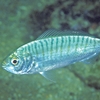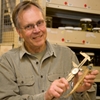General Description
Large slender shark with 7 pairs of gill slits, a single dorsal fin positioned far back on the body, a broad head with a short, blunt snout. Grey to greyish-brown above with scattered black and white speckles and spots; pale below. To a maximum length of 3 m, and a weight of 107 kg.
Biology
Opportunistic predators with sharp, jagged teeth in the upper jaw to grab and hold prey, and large, wide saw-like teeth in the lower jaw for cutting and tearing flesh. Although quite sluggish, Broadnose sharks are unpredictable and may be aggressive, and are responsible for a number of attacks on humans. Males mature at 1.5 m, females at 2.2 m.
Habitat
Large individuals often inhabit offshore waters, although they are also found near the bottom in deeper areas of bays and harbours in depths of 0-135 m. Smaller individuals are more commonly found inshore. Usually seen cruising over rocky reef habitats, as well as over sandy and muddy bottoms.
Open water
Distribution guide
Worldwide. Southern Australia.
Species Group
Depth
Shallow (1-30 m)
Deep ( > 30 m)
Water Column
Max Size
3 m
Diet
Carnivore
Harmful
Potentially dangerous to humans, with attacks reported.
Commercial Species
Yes
Global Dispersal
Recorded in Australia
Conservation Status
- DSE Advisory List : Not listed
- EPBC Act 1999 : Not listed
- IUCN Red List : Data Deficient





